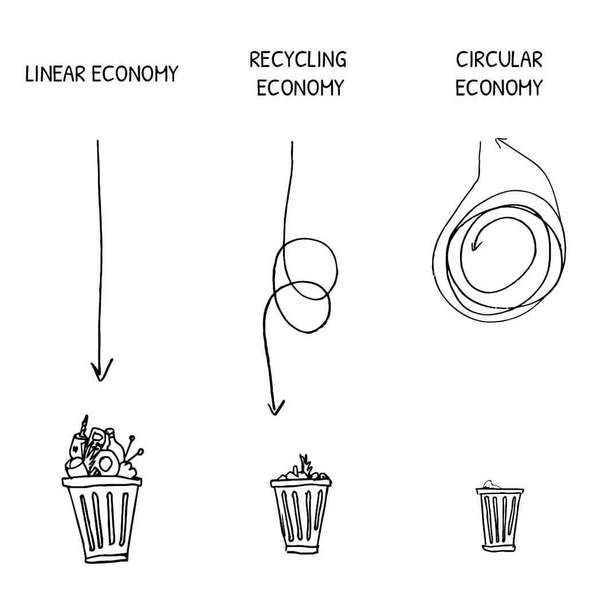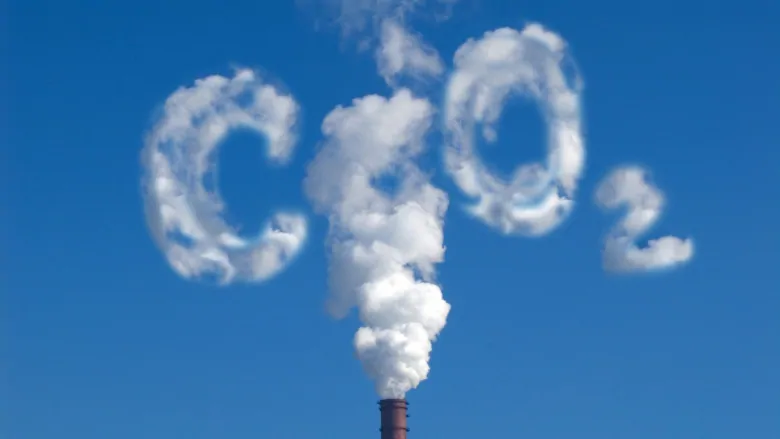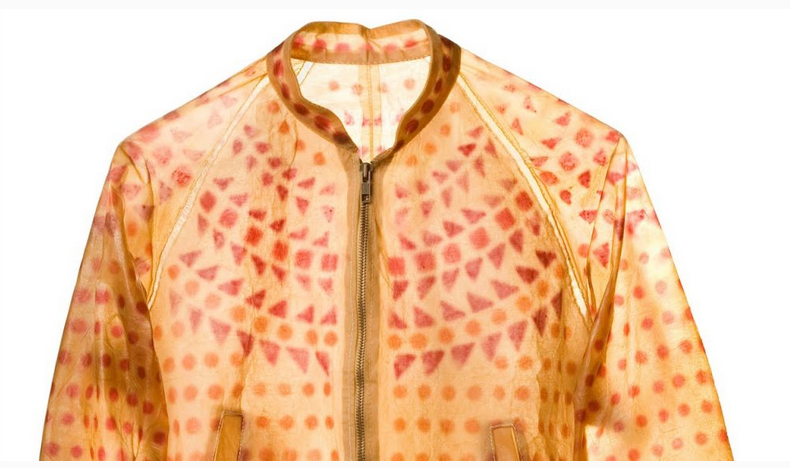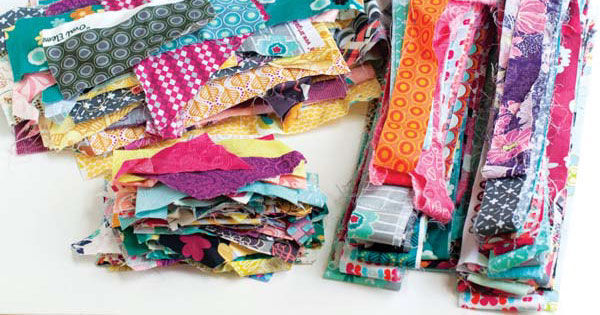The textile industry, the circular economy and us
- Science-by-Trianon

- May 17, 2020
- 9 min read
Updated: Apr 10, 2021

Circular economy is the new buzz word. But what is it precisely? And how does the textile industry fit in? How could it fit in?
If you have read the first part of this article “I have no clothes to wear”, you will be aware that the textile sector uses a huge quantities of raw materials and produces a substantial amount of waste.
This is partly because, to date, only a small amount of clothing textiles (as opposed to other textiles such as parachutes) textiles is recycled.
Most of these textiles are landfilled or incinerated thus carrying a high environmental impact.
In this second part, we will take a look at innovations in the apparel industry and how these innovations will help the textile industry to become a more sustainable industry.
1. What is circular economy?

To understand what a circular economy is, you need to know what a linear and a recycling economy is as well.
In a linear economy, waste is created.
Raw materials (such as fibres) are produced and then transformed into a product (in our case items of clothing) that are then used until they are finally discarded as waste.
In the linear economy value is generated by producing and selling as many products as possible.In a recycling economy, we give a second life to waste, and thus decrease the amount of waste produced.
In a recycling economy, the textile waste is recycled to give another pieces of fabric of reduced quality (for instance cleaning or polishing rags). This is called down-cycling.
In the circular economy, we do not produce waste…
Well, of course, we produce some waste.
However, as many of these inevitable waste streams as possible are used as starting materials for other activities, hence the amount of ‘residual waste, waste that cannot reasonable be used in any other activity is drastically reduced.
But this is more than this.
Circular economy is a new approach that alters the production process and could reduce the use of resources.
Resources use is minimised, reuse of products is maximized and raw materials are reused to a high standard.
So the circular economy requires much more than just recycling. It changes the way in which value is created and preserved, it changes production methods and which business models.The perspective on sustainability is very much different in a circular economy compared to a linear economy.
When working on sustainability within a linear economy, the focus is to minimise the ecological impact for the same output.
Within a circular economy, not only the ecological impact is minimized, but the economic and/or social impact is even positive.
So instead of take — make — dispose, we should reduce — repair — reuse and rethink.
The gap that the textile industry must close to be able to fit into a circular economy is waste creation.
Today, the textile apparel is more linear than circular.
The gap that the textile industry must close to be able to fit into a circular economy is waste creation.
As a matter of fact, lots of resources are used and polluted for an over production of clothes, that are discarded after having being worn a very short amount of times.
Extrapolating current trends,the rate of waste production by the fashion industry will increase by 60% by 2030, to an amount of 17.5 kg per person across the planet![1]
2. When textile apparels do not pollute
Using resources effectively and moving to renewable inputs is a necessary step for a sustainable textile economy.

Photo by mrjn Photography on Unsplash
As mentioned above and explained in part I, the textile industry is one of the largest consumers of water.
Water is the key component and is used as a solvent in pre-treatment and finishing processes such as washing, bleaching, dyeing, rinsing, and scouring.
According to the World Bank, textile dyeing, and treatment accounts for 17–20% of industrial water pollution. Until a few years back, there was no substitute for dyeing fabrics but by using water. [2]
Thanks to dry dyeing, a waterless dyeing technique invented by DyeCoo, this is now possible.
This process makes use of carbon dioxide to dye polyester textile materials.

Carbon dioxide in the supercritical state (31°C, 73.8 bar) is used to dye fabrics, providing same results as the conventional water-based methods.
Knowing that 55% of of the global fibre market is polyester, [3] and that you need 80 kg of water to process 1 kg of polyester [4], this is a substantial resource saved!
In addition, this technology only requires half the energy per kg of textile dyed, it does not use additional chemicals, and is, in consequence, responsible for reduced CO2 emissions — a veritable sustainability jackpot!
Carbon dioxide is readily available, biodegradable, and does not release any form of volatile organic compounds.
Moreover, it is non-toxic, non-flammable, and non-corrosive. These merits make it a very viable dyeing alternative.
The biggest merit of using carbon dioxide is that it can be recovered, and reused again from the process of dyeing, making it a cost-effective option.The denim industry has also embraced tools that eliminate water during garment finishing.
The Swiss chemicals giant Clariant created a new eco-friendly dye that uses 92% less water, 30% less energy, and saves up to 63% cotton waste and produces same colouring results when compared to conventional techniques.
This state-of-the-art process hands over improved colour fastness, better production of tones, and helps achieve deeper blues.[5]3. When the textile industry does not create waste
Bio-fibres are of course perfectly well known. Man has used wool spun from sheeps’ wool or silk from silkworms for ages and plant-based materials such as cotton aren’t exactly news any more.
Fibres grown from micro-organisms on the other hand are news, and very welcome news too.

Image by WikiImages from Pixabay
BioCouture is a design consultancy that is working on growing and reusing renewable or waste resources to create new materials such as fashion clothing, sportswear, or luxury items.
They are creating fibres and fabrics in the lab from living micro-organisms such as bacteria, fungi, algae, or yeasts.
Their aim is a completely natural product, 100% biodegradable that can be made into pieces of clothes, without creating polluting waste.
The materials can be designed to have specific properties, for instance they could be water repellent, anti-sweat, etc.
That is a truly sustainable product.Their main focus to date is R&D but some of their projects have been scaled up and exhibited. For example, their Biocouture Jacket produced from bacterial cellulose has been displayed at the London’s Science Museum.

Suzanne Lee’s Biocouture Jacket
They also have successful projects in the use of biowaste, such as the integration of crab shells into bike helmets. Crab shells are made of chitin, a compound well known for its protective properties. [6]
This could help to manufacture protective materials in a more sustainable way
Zero Waste Daniel turns clothing scraps into fashion.

In the process of making clothes, billions of tons of fabrics end up as waste, because they do not fit the clothing process pattern.
Zero Waste Daniel uses the pieces of fabrics left over during the process of making clothes, put them together and design new original pieces.
In that process one significant gap in the fashion industry waste problem is closed, i.e the pre-consumer waste.
Moreover, they manufacture everything in the USA, pay their employees fair wages, so they have a positive social, economic, and environmental impact.
Another innovation in the textile industry to make it sustainable thanks to zero waste production is 3D printing.
Julia Daviy has created the first collection of 3D printed clothes in 2019.
She has now a collection of accessories too.

Why do we think that 3D printing could be a sustainable manufacturing method, you wonder?
- It only uses the material it needs (thus eliminating waste during the manufacturing process)
- It could reuse plastic waste (solving one of the major problem today on the planet)
- 3D printing is easily accessible; companies could produce the needed clothing on site and wouldn't have to ship the clothing half-way around the globe.The down point is that we do not have enough data as yet to know if the volatile organic compounds released during 3D printing will be harmful in the long run.
So today it is not the replacement of traditional method but an interesting arrow to add to the quiver of textile making and definitely worth further investigation.
4. What about recycled clothes?
Many companies produce (in one way or another) recycled clothes. Some even get shown at major fashion events!
To name but a few:
Patagonia, the father of sustainable fashion, uses recycled plastic to create their fleece jackets.
Fabric for Freedom, promotes prolonging the life of used clothes by redesigning them into new pieces.
Wintervacht creates clothes from materials which lost their original function but still are in good condition. For example, they create jackets from second-hand blankets.
Preloved upcycle wool sweater destined for landfills.
They take vintage, old or discarded clothes, deconstruct them, turn them into fabrics and mixed them with new fabrics to transform them into a piece better than the original because of a new design, that is really unique and has added value.
All of their clothes are made in Canada.
Their social and economic impact comes from the fact that they understand how to take the best value of post-consumer clothes, they take from clothes bank. They sort them themselves, and thus generate value.For example the car industry, and hotels use cotton by the ton. Wool is the material most difficult to sell as 2nd hand, this is why they use it to make new sweaters out of it.
Corporate Social Responsibility is asking the big brands to earn money in socially responsible or at least acceptable ways.
But what about consumer social responsibility?
Our responsibility? The responsibility of consumers like you and me, to spend their money responsibly?
It is time to stop supporting brands that do not deserve your support, to make them change.
Your new mojo: Reduce, Repair, Reuse, Reinvent.
While researching this article we found the following companies which would actually fit better into the above mentioned part 1 of this little series because they are not really tech solutions. However, we found them important and interesting enough to draw attention to them here as well:
5. When innovations in services help us as consumers make the textile industry embrace the circular economy
5.1 Reduce
If you have no idea where to start, you can start today anyway. Ask a personal shopper to help you.
It seems very posh to say it that way, but he/she will help you to buy only what suits you, not to fall for the fast fashion trends that big brands push upon us every day, and you can give them the assignment to shop only brands that are sustainable.
Daily Outfit, will help you shop and rediscover your personal style. The founder ambitions to help you shine and express who you are thanks to the perfect wardrobe, and save the planet on the way by avoiding unnecessary buying.

You can also use a service such as the one provided by Lookiero. After a little quiz to understand who you are, they send you a box with a selection of items that you can try in the comfort of your home, and you pay only what actually suits you!
5.2 Repair

Image by Céline Martin from Pixabay
When you repair your clothes, it is not just something that you bought, this is something that you own. This sense of ownership changes the way you feel about the clothes and make you it longer.
If you are like me and can’t do it yourself, there are seamstress around practically every second corner. Go and talk to them, the repair can be unique and make your fixed piece of clothing unique.
5.3 Reuse
2nd hand shop are very fashionable today.
But you can push it a step further.
Meet Tammy Parrish, the owner of the Clothing Compass. She uses an online closet, so she can shop for anyone, wherever you are based. She does a pre-shop and clients buy the items they like.
Quite handy, don't you think? And the clothes can be designer clothes or not, and they are all second hand.

What about renting your clothes to avoid compulsive buying.
You pay a monthly subscription and you have a selection of clothes you can wear, and when you are bored, you send them back and get sent some undoubtedly fashionable new items.
The brand “MUD JEANS”, for example, has built its business model around this concept. Moreover, their efforts to produce jeans in a social, economic and environmentally sustainable way, deserves to be highlighted.
Rental Runway in New-York has pushed the concept to the extreme. They have hundreds of thousands of garment’s ranging from size zero to 22 that are processed, cleaned, and shipped to costumers all over the country.
They make sure the clothes are in perfect condition and look brand spanking new, when you receive them. They operate the world’s largest dry-cleaning facility and employ seamstresses to repair any faulty items.
And today lots of companies are working the same way. Even for men!
Look at The Black Tux, they offer tuxedos and suits for rent.
5.4 Reinvent
You are still sceptical? You need to reinvent yourself then, why not starting by your style?
Follow the day workshop “Reinventer votre style” (Reinvent your style) by Martine Inack-Thieulin (she can do it in English if you would like) and then jump!

So, lot of solutions exists to help us consume textile in a sustainable and fun way. You have no excuse!
NB: Some of you might think that we haven’t been fair because we didn’t not mention some of the big brands such as Nike, Adidas, Inditex, LVMH.
These companies made efforts towards a more environmental sustainability, however, a positive social impact is in our humble opinion yet to be proven.
___________________________________________________________________
[1] http://resyntex.eu/images/downloads/ValrieJBoiten_Textile_collection_strategies.pdf [Last accessed on May 17th, 2020]
[2] http://dx.doi.org/10.4236/ns.2012.41004 [Last accessed on May 17th, 2020]
[3] https://www.plasticsinsight.com/resin-intelligence/resin-prices/polyester/[Last accessed on May 17th 2020]
[4] Water in Textiles and Fashion: Consumption, Footprint, and Life Cycle Assessment edited by Subramanian Senthilkannan Muthu
[5] https://www.testextextile.com/eco-efficient-denim-dyeing-process-from-clariant/ [Last accessed on May 16th, 2020]
[6]https://ideas.ted.com/the-skirt-and-shoe-made-from-kombucha/ [Last accessed on May 17th, 2020]



Comments